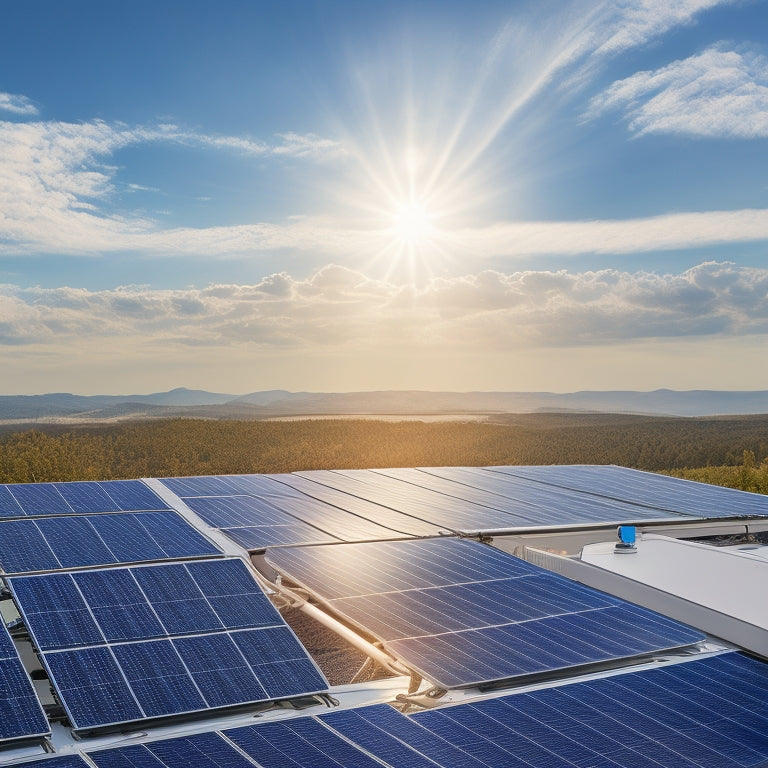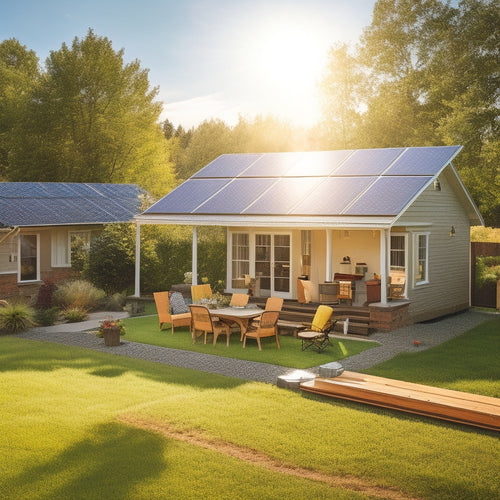
Solar Panel Inverters for Efficient Energy Conversion
Share
When it comes to utilizing the power of solar energy, you need a highly efficient solar panel inverter to convert DC power from your solar panels to usable AC power for your home or business. Inverters play a critical role in maximizing your system's energy output and reliability, and understanding how they work can make all the difference. From string inverters for large-scale commercial installations to microinverters for individual panel monitoring, there are various options available. By comprehending the complexities of inverter technology, you'll be better equipped to select the right one for your needs and access the full potential of your solar system - and that's just the starting point for optimizing your energy conversion.
Key Takeaways
- Solar panel inverters convert DC power from solar panels to AC power for home and business use, maximizing efficiency and reliability.
- Inverters regulate DC voltage, ensuring stable output and minimizing losses while protecting the DC circuit from faults.
- High-frequency switching and pulse-width modulation enhance energy conversion efficiency, with advanced cooling systems mitigating risks.
- Choosing the right inverter size is crucial, influenced by array size, configuration, peak sun hours, irradiance, and system losses for optimal performance.
- Regular maintenance, including software updates, inspections, and ventilation checks, is essential to prevent premature failure and extend inverter lifespan.
Understanding Solar Panel Inverters
Your solar panel system's heart is the inverter, an essential component responsible for converting DC power generated by the panels into AC power usable in your home or business.
This critical device guarantees a seamless shift from the DC energy produced by your solar panels to the AC power required by your electrical infrastructure. A high-quality inverter is fundamental to maximize the efficiency and reliability of your solar panel system.
You should expect an inverter lifespan of around 10 to 15 years, depending on the manufacturer and model. Regular inverter maintenance is key to extend its lifespan and prevent premature failure.
This involves checking for software updates, inspecting the unit for signs of wear and tear, and guaranteeing proper ventilation to prevent overheating.
How Inverters Convert DC Power
You're about to learn how solar panel inverters convert DC power into usable AC energy.
The DC power conversion process involves several stages, including maximum power point tracking, DC-DC conversion, and AC inversion.
DC Power Conversion Process
How do solar panel inverters convert the DC power generated by photovoltaic panels into usable AC power for your home or business? The DC power conversion process involves several essential steps.
First, the inverter regulates the DC voltage to guarantee a stable output, minimizing DC power losses. It then protects the DC circuit from overcurrent, overvoltage, and short-circuit faults.
The inverter also integrates DC energy storage systems, allowing you to store excess energy for later use. Moreover, it monitors and manages DC power quality, guaranteeing a stable and reliable output.
During the conversion process, the inverter also performs DC load management, adjusting the output to match your specific power requirements. In addition, it integrates with other DC systems, such as grid-tie systems, to guarantee seamless operation.
Finally, the inverter adheres to strict DC safety standards, guaranteeing the safe and efficient conversion of DC power into usable AC power.
Inverter Technology Explained
As the DC power conversion process reaches its climax, the inverter's technology takes center stage, converting the regulated DC voltage into usable AC power.
You're about to tap into the heart of solar inverter advancements, where state-of-the-art technology guarantees efficient energy conversion. Inside the inverter, a complex process unfolds, involving high-frequency switching and pulse-width modulation. This sophisticated technology enables the inverter to regulate the AC output voltage, frequency, and current, making it compatible with the grid.
However, inverter reliability issues can arise if the system isn't designed to handle harsh environmental conditions, such as extreme temperatures, humidity, or physical stress.
To mitigate these risks, manufacturers employ advanced cooling systems, protective casings, and sturdy circuitry. By understanding the complexities of inverter technology, you can appreciate the precision engineering that goes into creating reliable and efficient solar inverters.
With this knowledge, you'll be better equipped to select the right inverter for your solar panel system, guaranteeing ideal energy output and minimizing downtime.
Efficient Energy Output
Three key processes facilitate efficient energy output in solar panel inverters: high-frequency switching, pulse-width modulation, and DC-AC conversion. As you investigate these processes, you'll understand how inverters convert DC power from solar panels into usable AC energy.
High-frequency switching enables inverters to rapidly switch on and off, maximizing energy storage and peak performance. Pulse-width modulation fine-tunes the switching frequency to guarantee system compatibility and efficient energy transfer. Finally, DC-AC conversion alters the DC power into AC energy, ready for grid integration or direct use.
When selecting an inverter, consider installation tips, such as proper sizing and mounting, to guarantee peak energy output. Regular maintenance practices, like monitoring performance and cleaning the unit, will also help maintain peak performance.
A thorough cost analysis will help you weigh the benefits of different inverter options against their upfront costs and warranty considerations. As you look to the future, consider the environmental impact of your energy choices and the potential for future trends, such as advanced energy storage solutions, to further enhance your system's performance.
Types of Solar Inverters Available
You'll find two primary types of solar inverters on the market: string inverters and micro inverters.
Each has its own strengths and weaknesses, which you'll need to contemplate when selecting the right inverter for your solar panel system.
String Inverters
String inverters, the most traditional and widely used type of solar inverter, convert DC power from entire strings of solar panels into AC power that's fed directly into the electrical grid. As you consider using string inverters for your solar power system, it's crucial to weigh their advantages and drawbacks.
On the plus side, string inverter advantages include higher power outputs, which make them suitable for large-scale commercial and utility-scale solar farms. They're also more cost-effective than other types of inverters, and their maintenance is relatively straightforward.
Additionally, string inverters are widely available and supported by most manufacturers, making it easier to find replacement parts or technical support.
However, string inverter drawbacks include a single point of failure, which means that if one panel in the string is shaded or faulty, it can affect the entire string's performance.
You'll also need to guarantee that all panels in the string are identical and matched correctly to optimize energy production.
Micro Inverters
Microinverters, a more recent innovation in solar power technology, convert DC power from individual solar panels into AC power, allowing for greater flexibility and panel-level monitoring. This means you can monitor and control each panel's performance individually, identifying and addressing any issues promptly.
One of the micro inverter advantages is that it enables you to add or remove panels as needed, making it an ideal solution for complex or irregularly shaped roofs.
When it comes to micro inverter installation, you'll appreciate the ease and simplicity of the process. Since each microinverter is connected to a single panel, you don't need to worry about stringing multiple panels together, which reduces the risk of shading or mismatch losses.
Additionally, microinverters can be installed in a variety of configurations, making them suitable for both residential and commercial applications. With microinverters, you can maximize your energy harvest and enjoy a more efficient and reliable solar power system.
Grid-Tie Inverters for Homes
Efficiency meets convenience with grid-tie inverters, the backbone of residential solar panel systems.
As a homeowner, you're looking for a reliable way to utilize solar energy and feed it back into the grid. Grid-tie inverters make it possible, allowing you to generate your own home energy and offset your utility bills.
During the inverter installation process, verify system compatibility with your existing electrical infrastructure. With grid-tie inverters, you can enjoy significant solar savings and take a step towards energy independence.
Most manufacturers offer extensive inverter warranties, giving you peace of mind. For peak performance, follow maintenance tips such as regular cleaning and monitoring.
Stay up-to-date with technology advancements, which continue to improve efficiency and reduce cost considerations. Performance monitoring capabilities also enable you to track your energy production and make adjustments as needed.
Off-Grid Inverters for Remote Areas
You're likely familiar with the challenges of powering remote areas where traditional grid connections aren't feasible.
Off-grid inverters are designed to meet these unique power requirements, providing a reliable source of energy in areas where it's needed most.
Remote Power Requirements
Frequently, off-grid inverters are deployed in remote areas where traditional power infrastructure is unavailable or unreliable.
When you're dealing with remote site energy, you need reliable off-grid solutions that can provide consistent power.
You'll likely encounter unique power requirements that differ from traditional grid-tied systems. For instance, you might need to power communication equipment, lighting, or refrigeration systems.
Here are three key considerations for remote power requirements:
-
Power availability: You need to guarantee a consistent power supply, even during periods of low sunlight or extreme weather conditions.
-
Load management: You must manage your power load efficiently to prevent overloading or underutilization of your inverter.
-
System monitoring: You should have a reliable system monitoring setup to track performance, detect issues, and perform remote troubleshooting.
Grid Independence Solutions
Across remote areas, off-grid inverters serve as the backbone of grid independence solutions, enabling communities and operations to thrive beyond the reach of traditional power infrastructure.
You can achieve energy independence with off-grid inverters, designed to optimize energy production from renewable resources like solar panels.
These inverters efficiently manage power distribution, ensuring a reliable supply of electricity to your remote site.
Microinverters for Individual Panels
Microinverters for Individual Panels
What makes microinverters for individual panels so appealing is their ability to optimize energy production at the panel level. This means that each panel operates independently, allowing you to maximize energy production from each unit.
With traditional string inverters, the performance of the entire system is limited by the weakest panel. Microinverters eliminate this limitation, guaranteeing that every panel produces energy at its maximum capacity.
The benefits of microinverters are numerous:
-
Panel-level monitoring: You can track the performance of each individual panel, identifying potential issues and optimizing energy production.
-
Increased energy yield: Microinverters can increase energy production by up to 25% compared to traditional string inverters.
-
Design flexibility: Microinverters allow for more flexible system design, making it easier to accommodate complex roof layouts and shading issues.
However, installation challenges arise when working with microinverters.
You'll need to verify that each panel is properly connected and configured, which can be time-consuming and labor-intensive.
Despite these challenges, microinverters offer a powerful solution for optimizing energy production at the individual panel level.
String Inverters for Commercial Use
When it comes to commercial-scale solar installations, string inverters are often the go-to solution. You're likely to find them in large-scale solar farms, commercial rooftops, and utility-scale projects. The benefits of string inverters lie in their simplicity, reliability, and cost-effectiveness. They're ideal for large-scale installations where multiple strings of solar panels are connected in series.
Here's a breakdown of string inverter applications and benefits:
| Application | Benefits | Typical Installation Size |
|---|---|---|
| Commercial Rooftops | High efficiency, easy maintenance | 50-200 kW |
| Solar Farms | Scalability, reduced installation costs | 1-10 MW |
| Utility-Scale Projects | High power output, reliability | 10-100 MW |
String inverters are well-suited for commercial use due to their ability to handle high-power inputs and outputs. They're also more cost-effective than central inverters, making them a popular choice for large-scale solar installations. As you consider string inverters for your commercial-scale project, keep in mind the benefits they offer regarding efficiency, reliability, and cost savings.
Inverter Efficiency and Performance
As you evaluate string inverters for your commercial-scale solar installation, inverter efficiency and performance become essential factors to take into account, since they directly impact the overall energy yield and return on investment.
The inverter's efficiency rating, typically measured in percentages, indicates how effectively it converts DC power from the solar panels to AC power for the grid. A higher efficiency rating means less power loss and more energy production.
To optimize your inverter's performance, consider the following key factors:
-
Inverter lifespan: A longer lifespan reduces replacement costs and minimizes downtime, ensuring continuous energy production.
-
Efficiency under partial load: Since solar installations often operate at partial capacity, look for inverters that maintain high efficiency even when not running at full load.
-
Heat management: Inverters that effectively manage heat generation can reduce power loss and prolong their lifespan.
Monitoring and Tracking Systems
Optimizing inverter performance is only half the battle - you also need to guarantee you're getting the most out of your commercial-scale solar installation by tracking its energy production and identifying potential issues.
To achieve this, you'll require a strong monitoring and tracking system that provides real-time data and performance analytics. This system should be capable of tracking key performance indicators such as energy output, temperature, and voltage. With real-time data, you can identify underperforming strings or panels, and take corrective action to optimize energy production.
A thorough monitoring and tracking system should also provide historical data and trends, enabling you to make informed decisions about maintenance, upgrades, and future expansions.
Additionally, it should offer customizable alerts and notifications, ensuring you're promptly notified of any issues or anomalies.
Choosing the Right Inverter Size
Choosing the Right Inverter Size
Precision is key when it comes to selecting the right inverter size for your commercial-scale solar installation. You want to confirm that your inverter can handle the power output of your solar panels to maximize energy conversion.
Inverter sizing is critical to optimize your system's performance and efficiency.
To get it right, consider the following factors:
-
Array size and configuration: The number of solar panels, their wattage, and how they're connected impact your inverter sizing needs.
-
Peak sun hours and irradiance: The amount of sunlight your location receives affects the power output of your solar panels, which in turn influences inverter sizing.
-
System losses and efficiency: Account for energy losses due to temperature, wiring, and other factors to confirm your inverter can handle the reduced power output.
Frequently Asked Questions
Can I Install an Inverter Myself, or Do I Need a Professional?
You can attempt a DIY installation, but it's essential to weigh the risks: improper connections can lead to electrical shocks, fires, or system failures, so it's often safer and more efficient to hire a professional to guarantee a secure and optimized setup.
How Long Does a Typical Solar Inverter Last Before Needing Replacement?
Coincidentally, you're wondering about inverter lifespan just as you're considering going solar! Typically, your inverter lasts 10-15 years, but its lifespan depends on factors like quality, temperature, and maintenance - so follow tips like regular cleaning and firmware updates to maximize its life.
Are Solar Inverters Compatible With All Types of Solar Panels?
You'll find that solar inverters aren't universally compatible with all solar panel types, as inverter specifications must match the panel's voltage, current, and power output; verify a compatible match by checking the inverter's datasheet against your panel's specifications.
Do Inverters Have Built-In Surge Protection for Extreme Weather?
You'll find that many modern inverters have built-in surge protection to shield your system from extreme weather events, such as lightning strikes or power grid spikes, ensuring uninterrupted energy harvesting and system reliability.
Can I Upgrade My Inverter if I Add More Solar Panels Later?
When you add more solar panels, you can upgrade your inverter if it's not maxed out on capacity, allowing for seamless solar expansion; check your inverter's specifications to verify it can handle the increased power output.
Conclusion
As you maneuver through the world of solar panel inverters, remember that finding the right one is like piecing together a puzzle - each component must fit perfectly to reveal efficient energy conversion. With a comprehensive grasp of inverter types, efficiency, and performance, you'll be one step closer to utilizing the sun's power. Now, it's time to connect the dots and choose an inverter that's customized to your unique needs, ensuring a seamless flow of energy from rooftop to outlet.
Related Posts
-

Steps to Prepare for Solar Installation
To prepare for solar installation, start by evaluating your current energy consumption and future needs to determine ...
-

Innovative Sustainable Materials for Energy-Efficient Homes
Innovative sustainable materials enable you to create energy-efficient homes while promoting environmental responsibi...
-

Eco-Friendly Home Design Ideas for Beginners
If you're starting your eco-friendly home design expedition, focus on sustainable materials like recycled wood or rec...


